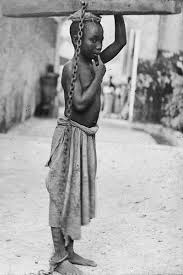Today is international Day of Remembrance of the victims of Slavery and the Transatlantic slave trade.This day is set aside to commemorate Africans who were part of the struggles and tragedy of the transatlantic slave venture over centuries ago.

On March 25, the UN marks the International Day of Remembrance of the Victims of Slavery and the Transatlantic Slave Trade to honor those who suffered and died at the hands of the transatlantic slavery system.The theme for 2019 celebration is tagged:”Remember Slavery,The Power of the Arts for Justice”
In the transatlantic slave trade (15th to 19th centuries), between 12 and 15 million men, women and children were trafficked from Africa to the Western Hemisphere for the purposes of forced labor. This Maafia was perpetrated by major European countries. Among the world’s leading slave trading powers, Britain transported at least 2-3 million people in the 18th century alone.
Since the time of the Transatlantic Slave Trade, the arts have been used to confront slavery, empower enslaved communities and honour those who made freedom possible. They have also been vital tools in commemorating past struggles, highlighting ongoing injustices and celebrating the achievements of people of African descent. The 2019 theme therefore draws attention to the many examples of artistic expression – including memorials, music, dance and architecture – that have helped us to remember the history and consequences of the Transatlantic Slave Trade.
Although slave trade had been long abolished and it is marked every year, ,most people still suffer and experience the adverse effect of modern day slavery. What do I mean by that?
Even though abolished, there are still slave masters who perpetrate this evil hiddenly. Exploitation of people is common in Africa. Most are denied freedom of expression, movement and incurring mental and physical abuse to others, especially to the vulnerable people.
Having housemaids is not a crime but the ways they are being treated is the crime. Most people in Africa, Nigeria in particular have ‘house slaves’ not housemaids.
An experience of a young girl of 13 who was promised good care by her aunt before she was taken from her mother to Abuja. She ended up being used as a house slave and a babysitter for a banker; thus denied her the opportunity of going to school, and did not even pay her dues, because the aunt was the one collecting the payment.
Modern day Slavery is in different irksome ways.Slavery which was abolished centuries past did not end but rather changing forms, and these forms of slavery are tagged modern slavery.Another is a wife who is battered and maltreated daily by someone who she is legally’enslaved’ to, I don’t call that marriage but enslavement.
Records have it that the employment of children as domestic workers, as well as the procurement of persons for sexual exploitation and forced labour, are some of the numerous examples of modern day slavery in Nigeria. And that ignorance and misconceptions lead many Nigerians to seek greener pasture where it does not exist.
Well meaning Nigerians and NGOs are now adopting a means to bring down the number of modern slaves in Nigeria, through awareness campaigns to rural communities where most victims were taken from.Also is awareness for the youths, parents in communities, particularly, the area where victims come from as a result of ignorance and lack of education.
Those who have the knowledge of the bane of modern day slavery should reach out and educate people or report any case of slavery to the National Agency for the Prohibition of Trafficking in Persons, NAPTIP, an Agency in charge of such issues via: info@naptip.gov.ng , or call the following numbers:+234 703 0000 203, O8002255627847 (Toll-free number).
